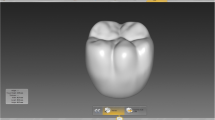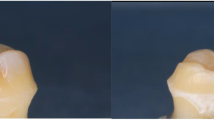Abstract
Objectives
The aim of this study is to investigate the performance and fracture resistance of different CAD/CAM ceramic and composite materials as implant- or tooth-supported single crowns with respect to the clinical procedure (screwed/bonded restoration).
Materials and methods
One hundred twenty crowns were fabricated on implants or human molar teeth simulating (a) chairside procedure ([CHAIR] implant crown bonded to abutment), (b) labside procedure ([LAB] abutment and implant crown bonded in laboratory, screwed chairside), and (c) reference ([TOOTH] crowns luted on human teeth). Four materials were investigated: ZLS (zirconia-reinforced lithium silicate ceramic; Celtra Duo, Degudent: polished (P)/crystallized (C)), RB (resin-based composite; Cerasmart, GC), and RIC (resin-infiltrated ceramic; Enamic, Vita-Zahnfabrik). LiS (lithiumdisilicate; Emax CAD, Ivoclar-Vivadent) served as reference. Combined thermal cycling and mechanical loading (TCML) was performed simulating a 5-year clinical situation. Fracture force was determined. Data were statistically analyzed (Kolmogorov-Smirnov test, one-way ANOVA; post hoc Bonferroni, α = 0.05).
Results
One crown of ZLS_C[LAB] (1,200,000 cycles) and RB[CHAIR] (890 cycles) failed during TCML. Fracture values varied between 977.7 N(RB) and 3070.4 N(LiS)[CHAIR], 1130.6 N(RB) and 2998.1 N(LiS)[LAB], and 1802.4 N(ZLS) and 2664.3 N(LiS)[TOOTH]. Significantly (p < 0.003) different forces were found between the materials in all three groups. ZLS_C, RIC, and RB showed significantly (p < 0.014) different values for the individual groups.
Conclusions
Partly ceramic and resin-based materials performed differently on implant or tooth abutments. The insertion of a screw channel reduced the stability for individual crown materials. Insertion of the screw channel should be performed carefully.
Clinical relevance
All restorations were in a range where clinical application seems not restricted, but insertion of a screw channel might reduce stability of individual materials.




Similar content being viewed by others
References
Pjetursson BE, Karoussis I, Bürgin W, Brägger U, Lang NP (2005) Patients’ satisfaction following implant therapy. A 10-year prospective cohort study. Clin Oral Implants Res 16:185–193
Magne P, Silva M, Oderich E, Boff LL, Enciso R (2013) Damping behavior of implant-supported restorations. Clin Oral Implants Res 24:143–148
de Kok P, Kleverlaan CJ, de Jager N, Kuijs R, Feilzer AJ (2015) Mechanical performance of implant-supported posterior crowns. J Prosthet Dent 114:59–66
Alikhasi M, Monzavi A, Bassir SH, Naini RB, Khosronedjad N, Keshavarz S (2013) A comparison of precision of fit, rotational freedom, and torque loss with copy-milled zirconia and prefabricated titanium abutments. Int J Oral Maxillofac Implants 28:996–1002
Gehrke P, Johannson D, Fischer C, Stawarczyk B, Beuer F (2015) In vitro fatigue and fracture resistance of one- and two-piece CAD/CAM zirconia implant abutments. Int J Oral Maxillofac Implants 30:546–554
Baldassarri M, Hjerppe J, Romeo D, Fickl S, Van Thompson P, Stappert CFJ (2012) Marginal accuracy of three implant-ceramic abutment configurations. Int J Oral Maxillofac Implants 27:537–543
Zarone F, Sorrentino R, Traini T, Di lorio D, Caputi S (2007) Fracture resistance of implant-supported screw- versus cement-retained porcelain fused to metal single crowns: SEM fractographic analysis. Dent Mater 23:296–301
Al-Omari WM, Shadid R, Abu-Naba’a L, El Masoud B (2010) Porcelain fracture resistance of screw-retained, cement-retained, and screw-cement-retained implant-supported metal ceramic posterior crowns. J Prosthodont 19:263–273
Karl M, Graef F, Taylor TD, Heckmann SM (2007) In vitro effect of load cycling on metal-ceramic cement- and screw-retained implant restorations. J Prosthet Dent 97:137–140
Torrado E, Ercoli C, Al Mardini M, Graser GN, Tallents RH, Cordaro L (2004) A comparison of the porcelain fracture resistance of screw-retained and cement-retained implant-supported metal-ceramic crowns. J Prosthet Dent 91:532–537
Patzelt SBM, Spies BC, Kohal RJ (2015) CAD/CAM-fabricated implant-supported restorations: a systematic review. Clin Oral Implants Res 26(Suppl 11):77–85
Rosentritt M, Behr M, Scharnagl P, Handel G, Kolbeck C (2011) Influence of resilient support of abutment teeth on fracture resistance of all-ceramic fixed partial dentures: an in vitro study. Int J Prosthodont 24:465–468
Rosentritt M, Kolbeck C, Handel G, Schneider-Feyrer S, Behr M (2011) Influence of the fabrication process on the in vitro performance of fixed dental prostheses with zirconia substructures. Clin Oral Investig 15:1007–1012
Parfitt GJ (1960) Measurement of the physiological mobility of individual teeth in an axial direction. J Dent Res 39:608–618
Rosentritt M, Behr M, Van der Zel JM, Feilzer AJ (2009) Approach for valuating the influence of laboratory simulation. Dent Mater 25:348–352
Rosentritt M, Siavikis G, Behr M, Kolbeck C, Handel G (2008) Approach for valuating the significance of laboratory simulation. J Dent 36:1048–1053
Derafshi R, Farzin M, Taghva M, Heidary H, Atashkar B (2015) The effects of new design of access hole on porcelain fracture resistance of implant-supported crowns. J Dent (Shīrāz) 16:61–67
Stona D, Burnett LH, Mota EG, Spohr AM (2015) Fracture resistance of computer-aided design and computer-aided manufacturing ceramic crowns cemented on solid abutments. J Am Dent Assoc 146:501–507
Shembish FA, Tong H, Kaizer M, Janal MN, Van Thompson P, Opdam NJ, Zhang Y (2016) Fatigue resistance of CAD/CAM resin composite molar crowns. Dent Mater. doi:10.1016/j.dental.2015.12.005
Menini M, Conserva E, Tealdo T, Bevilacqua M, Pera F, Signori A, Pera P (2013) Shock absorption capacity of restorative materials for dental implant prostheses: an in vitro study. Int J Prosthodont 26:549–556
Conserva E, Menini M, Tealdo T, Bevilacqua M, Ravera G, Pera F, Pera P (2009) The use of a masticatory robot to analyze the shock absorption capacity of different restorative materials for prosthetic implants: a preliminary report. Int J Prosthodont 22:53–55
Schepke U, Meijer HJ, Vermeulen KM, Raghoebar GM, Cune MS (2015) Clinical bonding of resin nano ceramic restorations to zirconia abutments: a case series within a randomized clinical trial. Clin Implant Dent Relat Res. doi:10.1111/cid.12382
Zesewitz TF, Knauber AW, Northdurft FP (2014) Fracture resistance of a selection of full-contour all-ceramic crowns: an in vitro study. Int J Prosthodont 27:264–266
Weyhrauch M, Igiel C, Scheller H, Weibrich G, Lehmann KM (2016) Fracture strength of monolithic all-ceramic crowns on titanium implant abutments. Int J Oral Maxillofac Implants 31:304–309
Preis V, Behr M, Hahnel S, Rosentritt M (2015) Influence of cementation on in vitro performance, marginal adaptation and fracture resistance of CAD/CAM-fabricated ZLS molar crowns. Dent Mater 31:1363–1369
Varga S, Spalj S, Lapter Varga M, Anic Milosevic S, Mestrovic S, Slaj M (2011) Maximum voluntary molar bite force in subjects with normal occlusion. Eur J Orthod 33:427–433
Romeo E, Lops D, Margutti E, Ghisolfi M, Chiapasco M, Vogel G (2004) Long-term survival and success of oral implants in the treatment of full and partial arches: a 7-year prospective study with the ITI dental implant system. Int J Oral Maxillofac Implants 19:247–259
Bijjargi S, Chowdhary R (2013) Stress dissipation in the bone through various crown materials of dental implant restoration: a 2-D finite element analysis. J Investig Clin Dent 4:172–177
Jung RE, Pjetursson BE, Glauser R, Zembic A, Zwahlen M, Lang NP (2008) A systematic review of the 5-year survival and complication rates of implant-supported single crowns. Clin Oral Implants Res 19:119–130
Baran G, Boberick K, McCool J (2001) Fatigue of restorative materials. Crit Rev Oral Biol Med 12:350–360
Kim Y, Oh T, Misch CE, Wang H (2005) Occlusal considerations in implant therapy: clinical guidelines with biomechanical rationale. Clin Oral Implants Res 16:26–35
Ferrario VF, Sforza C, Zanotti G, Tartaglia GM (2004) Maximal bite forces in healthy young adults as predicted by surface electromyography. J Dent 32:451–457
Earthman JC, Li Y, VanSchoiack LR, Sheets CG, Wu JC (2006) Reconstructive materials and bone tissue engineering in implant dentistry. Dent Clin North Am 50:229–44
Vanoorbeek S, Vandamme K, Lijnen I, Naert I (2010) Computer-aided designed/computer-assisted manufactured composite resin versus ceramic single-tooth restorations: a 3-year clinical study. Int J Prosthodont 23:223–230
Preis V, Kammermeier A, Handel G, Rosentritt M (2016) In vitro performance of two-piece zirconia implant systems for anterior application. Dent Mater 32:765–774
Rosentritt M, Hagemann A, Hahnel S, Behr M, Preis V (2014) In vitro performance of zirconia and titanium implant/abutment systems for anterior application. J Dent 42:1019–1026
Preis V, Behr M, Hahnel S, Handel G, Rosentritt M (2012) In vitro failure and fracture resistance of veneered and full-contour zirconia restorations. J Dent 40:921–928
Rosentritt M, Behr M, Gebhard R, Handel G (2006) Influence of stress simulation parameters on the fracture strength of all-ceramic fixed-partial dentures. Dent Mater 22:176–182
Vrochari AD, Petropoulou A, Chronopoulos V, Polydorou O, Massey W, Hellwig E (2015) Evaluation of surface roughness of ceramic and resin composite material used for conservative indirect restorations, after repolishing by intraoral means. J Prosthodont. doi:10.1111/jopr.12390
Teughels W, van Assche N, Sliepen I, Quirynen M (2006) Effect of material characteristics and/or surface topography on biofilm development. Clin Oral Implants Res 17(Suppl 2):68–81
Acknowledgments
We would like to thank the manufacturers for providing the materials.
Author information
Authors and Affiliations
Corresponding author
Ethics declarations
This article does not contain any studies with human participants or animals performed by any of the authors.
Conflict of interest
Prof. Dr. Martin Rosentritt declares that he has third-party research projects with all dental companies, including Degudent, D, GC, B, Ivoclar-Vivadent, FL., and Vita Zahnfabrik, D.
Prof. Dr. Sebastian Hahnel declares that he has no conflict of interest.
Dr. Frank Engelhardt declares that he has no conflict of interest.
Prof. Dr. Michael Behr declares that he has no conflict of interest.
Dr. Verena Preis declares that she has no conflict of interest.
Informed consent
For this type of study, formal consent is not required.
Funding
No.
Rights and permissions
About this article
Cite this article
Rosentritt, M., Hahnel, S., Engelhardt, F. et al. In vitro performance and fracture resistance of CAD/CAM-fabricated implant supported molar crowns. Clin Oral Invest 21, 1213–1219 (2017). https://doi.org/10.1007/s00784-016-1898-9
Received:
Accepted:
Published:
Issue Date:
DOI: https://doi.org/10.1007/s00784-016-1898-9




